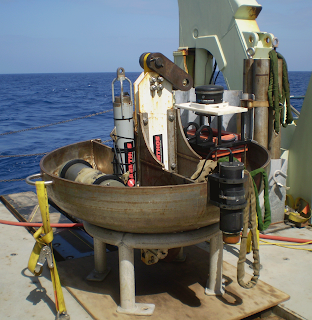 |
Tropical Atlantic sunset from the R/V Knorr -- March 2010.
photo by G. Dwyer |
We probably won't see another beautiful ocean sunset like this one for a while.
We're finished with our work here. All of our samples stored away for shipping and we're headed for dry land. On the way we've been cleaning the labs and our rooms, updating sample lists, filling out customs forms, calculating the weight of all of our samples (about 9000 metric tons!), and making sure all is well with the end-of-the-cruise to-do list.
 |
| Lead PI: Paul Baker, Duke University. |
Its been a productive cruise. It was a long time coming, but it was worth the wait. I can't remember exactly when Paul first had the idea for this project. It was at least 6 or 8 years ago (maybe more). But, it finally became a possibility during our Fulbright sabbaticals in Brazil, in 2005. It was there that we meet and started to collaborate with our Brazilian colleagues. Pedro Tapia (of UFPA -- Universidade Federal do Para, in Belem) was our Fulbright host. He introduced us to many people during our 5 months in Brazil. And, importantly, although the Fulbright Federation sent us in the Amazon (yes, we developed projects and collaborations there as well), we managed to spend some time in Niteroi with Cleverson Silva (of UFF -- Universidade Federal Fluminense).
 |
| Collaborating Investigator: Cleverson Silva, UFF. |
Cleverson, without whom this work in Brazil would not have been possible, introduced us to people from Petrobas, from the Brazilian Navy, and from other universities -- people who would prove to be very supportive of our research. His participation in this research brings valuable expertise in seismic stratigraphy, marine geology, and the geologic history of the Amazon fan, as well as much appreciated intellectual collaboration and commitment to the project's goals.
After several years of talking about it, thinking about it, developing hypotheses, worrying about logistics, and considering all of the other possible ways to test his hypotheses about the paleoclimate history of the Amazon Basin, Paul was finally ready to submit a proposal for this cruise.
 |
| PI: David Hollister, USF. |
He realized immediately that this work would benefit from detailed studies of the biomass, hence needed a good organic geochemist on board. David Hollander, from the University of South Florida (USF) fit the bill perfectly. His expertise in marine biogechemistry, especially his work examining the terrestrial influx to marine systems was just what the project need. Paul was glad when Dave agreed to join the project as a PI.
Finally, Paul knew that the project would be greatly improved with his Duke colleague, Gary Dwyer, along to participate in the biostratigraphic studies and to take a lead in the foram/ostracod work that was needed to reconstruct paleo-SSTs and paleo-SSSs (sea-surface temperatures and sea surface salinities). With Gary signed on, Paul had his team assembled: PIs Baker (Duke) and Hollander (USF), co-PI Dwyer (Duke), and international collaborator Silva (UFF).
 |
| Co-PI: Gary Dwyer, Duke University. |
It took a few attempts to get the proposal funded, but Paul did not give up. The proposal improved every time it was submitted. Also, the complexity of the logistical details became clearer and clearer with each passing day.
Fortunately, Cleverson was there all along, helping with site selection, providing geophysical data to support the project, and helping us handle all of the bureaucratic details that are necessary to do work in Brazilian waters (including heroically translating lengthy documents -- to and from Portuguese -- on very tight deadlines!). Importantly, he helped us obtain appropriate permissions from the Brazilian Navy and Brazilian Customs, and he introduced us to a new friend: Renato Rocha, our Brazilian Navy observer for the cruise.
 |
| Marinah do Brasil (our Brazilian Navy observer for the cruise): Renato Rocha. |
Renato has been with us from the time we left Barbados. I'm not sure he is as excited about the geology as we are, but he is always upbeat and never far from the action. We're glad he was with us!
Excellent scientific research projects are rarely easy to put together. But, as with this one, they are usually worth the effort. Still, as good as this cruise has been, we're all excited to be heading to shore -- especially because "shore" in this case is Fortaleza, Brazil!
We'll have some work to do at dock (hauling core in preparation for shipping from Brazil to WHOI) before we can call it quits. But, we're all hoping to get at least an afternoon on the beach (
aah . . . the Brazilian beach scene!) before heading back to the states.









































































